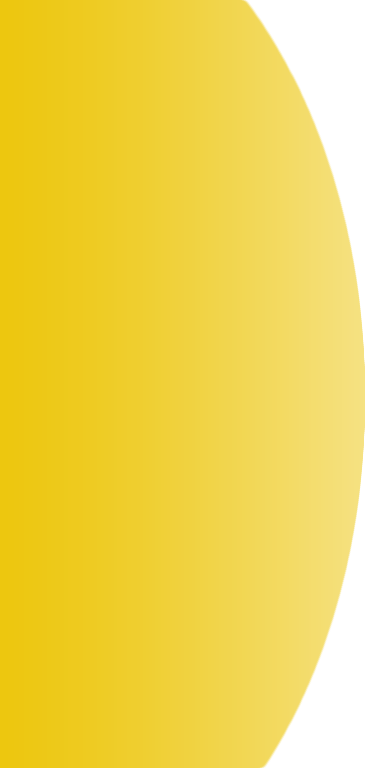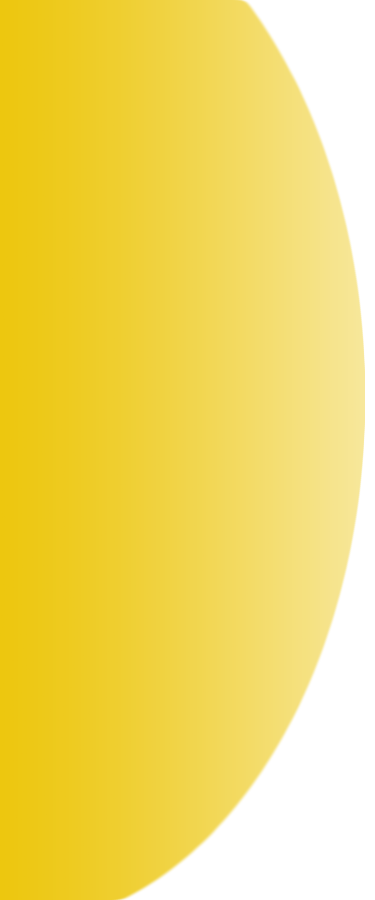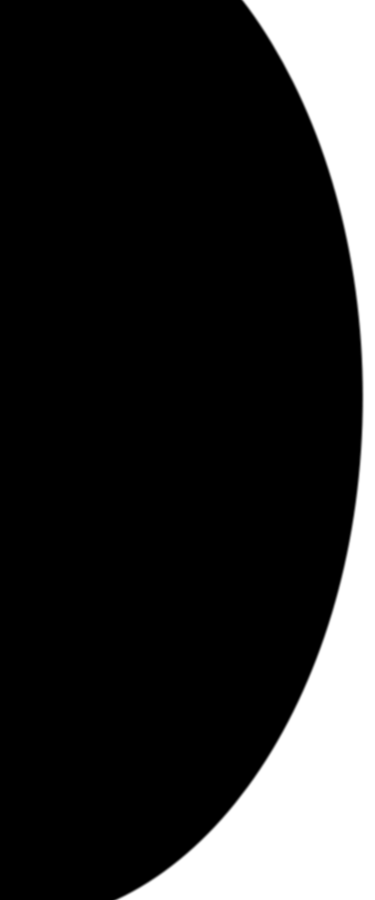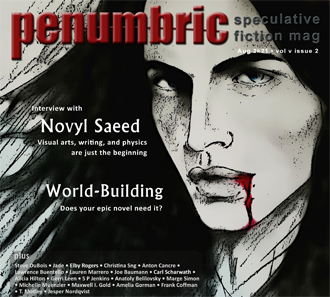From individuals to whole worlds, Novyl Saeed's creative works are always moving forward
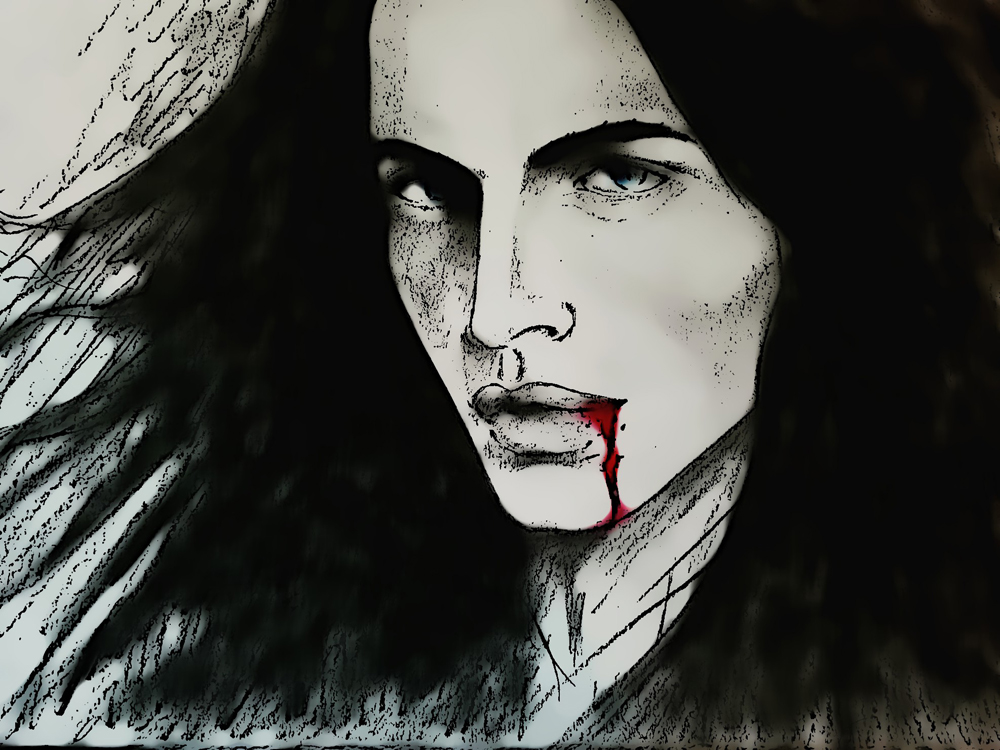
Novyl Saeed's Revitalized. He feels his returning power surge through him. Electrifying. Filling him. Making him whole again. His lover's blood trickling down his chin. He is sated. For now.
Novyl Saeed, better known in the pages of Penumbric as Novyl the Mysterious, comes from a long line of creators and artists—her parents are artists, and, according to her father, her ancestors were engineers on the Taj Mahal. She has been creating, whether in writing, drawing, or otherwise, for as long as she can remember. "It is as natural to me," she says in an interview with Loud Coffee, "as breathing."
It seemed just as natural that we interview Novyl for Penumbric—her art has been featured on these pages many times, including on the cover. And she's working on far more than visual arts ...
* * *
You wear many hats—those of us at Penumbric know you as an artist, but you also have a degree in physics. Did you start off thinking of going into science? Or art? Or something else?
Well, if I think back to my earliest memories and what I wanted to do, the one that sticks out the most, is that I wanted to WRITE.
However, I have memories going much further back than that.
When I was 6yrs old, I performed as Goldilocks in a school play. That was a lot of fun. I was chosen for my long, light brown hair, which had gold glitter sprayed into it. Goldilocks! I really did enjoy performing.
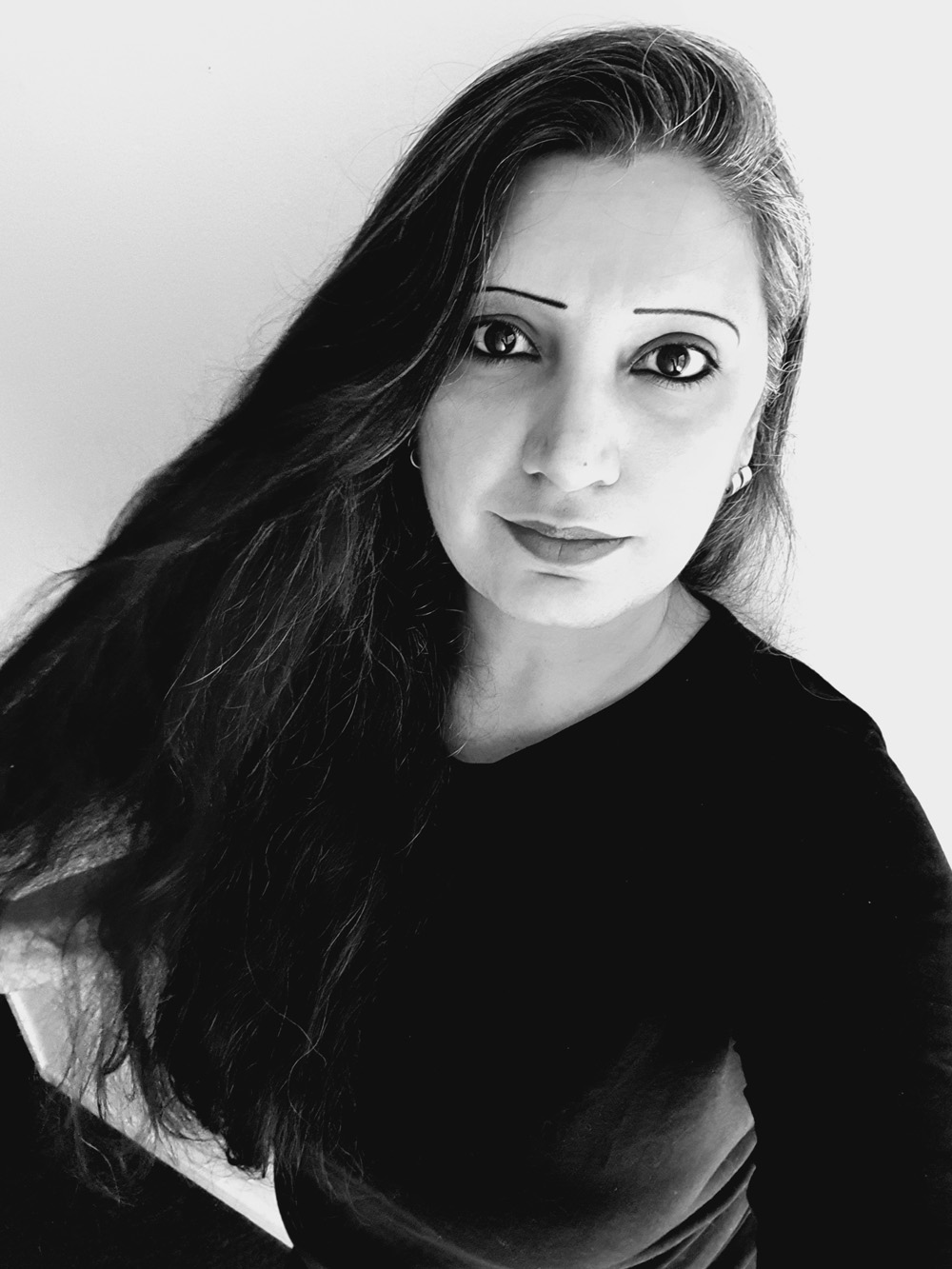
Novyl Saeed.
It was around about that time that we also toured Europe and went to all the galleries. I had been exposed to art since the day I was born— what with my father being an artist and later, my mother as well.
But it was when I was around 9 or 10 that I was first introduced to the concept of reading and books. And that pretty much was where my passion for writing took off. I wanted to tell stories as well.
I had an extremely fertile imagination and was an extremely dreamy child. I’d been known to randomly walk around the entire school, peeking into other classes, on the pretence of taking a bathroom break. Troublemaker. And curious.
I’ve always had this passion for learning and understanding. That has never stopped.
I had a dream once, when I was 19, where someone reiterated to me that the “Treasure is in the books!” I took it as a sign that I needed to follow knowledge. I needed to learn more, understand better.
My love of books never left though. Even when I got to New Zealand, I was still into reading, and it was my reading habits that led me into science.
In fact, the epiphany to study physics struck me as I was reading Greg Bear’s Eon. This was when I was around 24, just before I got pregnant with my second child. I was reading all about the asteroid that was bigger on the inside and the thought came to me that I really enjoy this stuff, this science, this physics ... so why am I not studying it, dammit?
I also remembered how I loved looking up at the stars and how homesick I felt when I did so. And my dream to find the treasure in the books.
I was pregnant with my son when I enrolled at university, again, to study physics. Two weeks after my c-section, I was back in classes full time. I’d study with a baby on my lap. But I never gave up. I knew I was passionate about this and I stuck with it, even though I struggled and failed some courses. I had to take Calculus TWICE before getting an A. I didn’t give up. I had my dreams.
Another reason for sticking with it was that I wanted to write better science fiction. I certainly couldn’t write techno-babble geek speak without actually knowing what its all about, now could I?
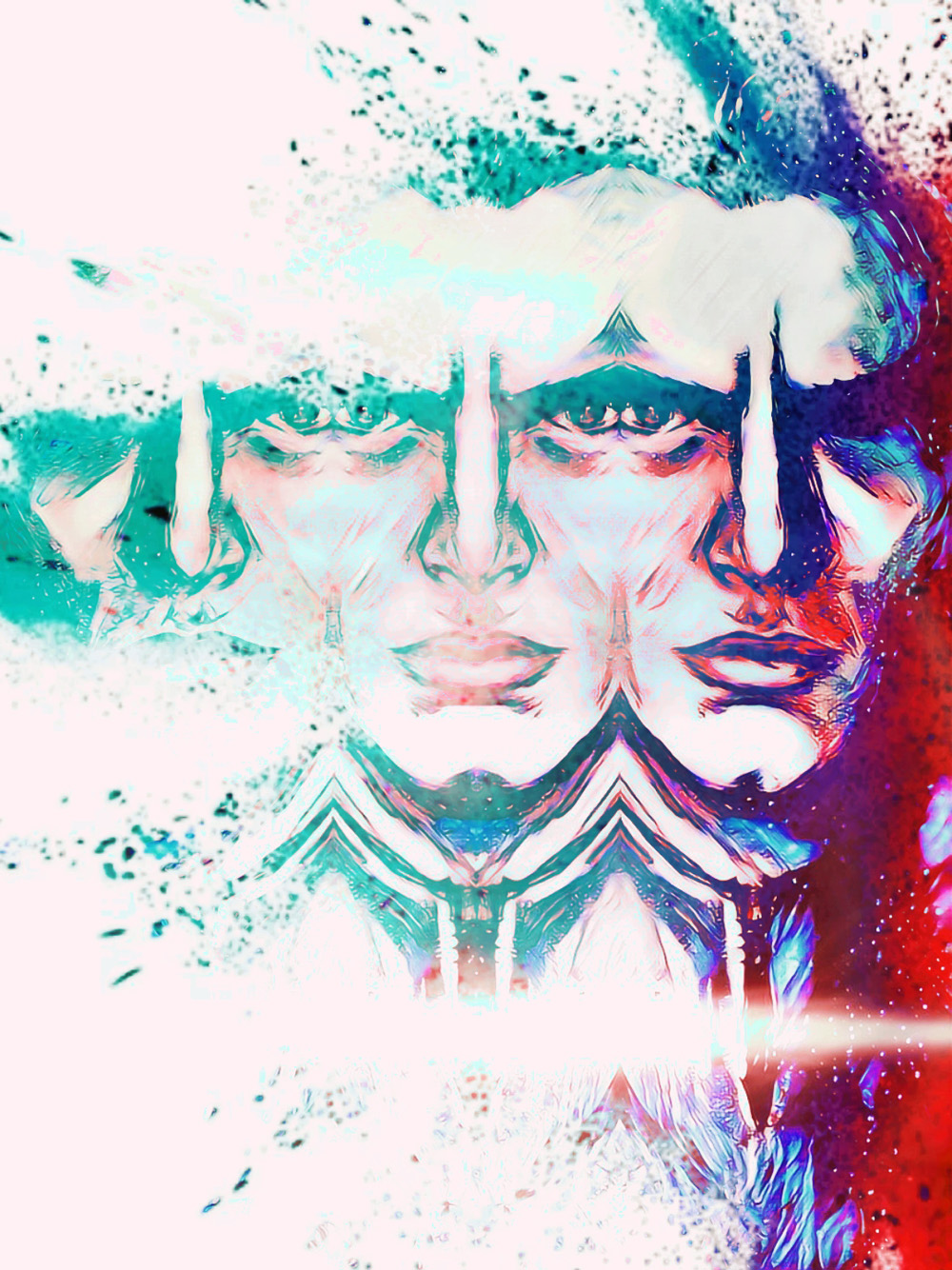
The Many Faces of Me by Novyl Saeed.
These were the years where I hardly did any art, because my creative side was battling with differential equations.
But I’m glad I did my degree. Super glad. Because it taught me SO MUCH. SO SO MUCH. I didn’t just learn academically. I learned emotionally, mentally, and spiritually. I grew as a person.
Art was a springboard I needed to jump into science.
And science was the platform I needed to understand art better.
My own little aside: I started off going into astrophysics, but then, or at the same time, decided I wanted to write science fiction and got a degree in English ... then went back to computer science, and now have ended up somewhere in the “between”: a programmer developing AI whilst creating games and running a spec fic magazine. Have you ended up in a similar “between” situation? In what way do you combine all these different elements in your life (if you do)?
Currently, I work as an advisor and analyst with a government agency and I do art and writing on the side, for fun, and sometimes, I take commissions.
I guess it’s an in between situation.
You know, I spent the last ten or fifteen years just focussed on getting my degree in Physics and then creating some kind of solid career for myself. However, the thought of writing a book was never far from my mind. I always told myself I would do it, but later, when I had some kind of foundation for myself. Some security.
Now that later seems to have arrived, I think. And that’s what I’ve been realizing the last couple of years. Which takes me to your next question.
You mention elsewhere (in the Loud Coffee interview) that you only really got back into art a few years ago, and you do a lot of speculative fiction portrait art. What is your favourite kind of art to do? Favourite medium? Favourite subjects?
Yes, I did get back into it a couple of years ago. Started doing some character art, because I love drawing from imagination and letting it take me where it wants.
I love drawing faces. Figures. Humans are my favourite subjects. Fictional humans even more so. There is so much that you can show in a face. Character. Feeling. Emotion. Story.
Why are we here? We are here to understand ourselves better, and art is that medium in which to understand it. Be it drawing or writing.
My favorite medium has to be the humble pencil. Or charcoal. These are basic mediums that humans have been working with for thousands of years. There is something rustic and true about the humble pencil. You can write with it and you can draw with it. I am getting into more watercolors these days and markers and experimenting with different mediums. But the pencil remains my top choice.
My favourite subjects would have to be art and science—which pretty much covers everything! Haha! But seriously—I am curious about the world and the universe—so everything seems interesting. Except golf.
Do you think art influences or enhances speculative fiction writing, and in what way? And the other way round, of course: How does writing influence/enhance art? Or are they very separate things?
Speculative fiction writing IS art.
Writing is an ART. They are not separate things but two different forms of expression of the same thing.
You can express emotion via a painting or illustration, but you can also do it in words.
If you have words, it’s good. If you have words AND pictures, it’s even better. So much more for the senses to absorb.
You are writing a novel as well. Can you tell us about that?
My book. My fantasy epic. I’ve been working on it for years now and I’m nowhere near done. But through the process of writing this book, I have learned so much.
I have learned about characters and how to build them up and break them down. I have learned about pacing and plotting. I have learned how to be authentic in my writing. And there is so much more I am learning still.
There is so much story in my head that I need to first edit the bits in my brain, before I can write it. Picking out the things that matter to move the story forward. This has been another learning curve for me.
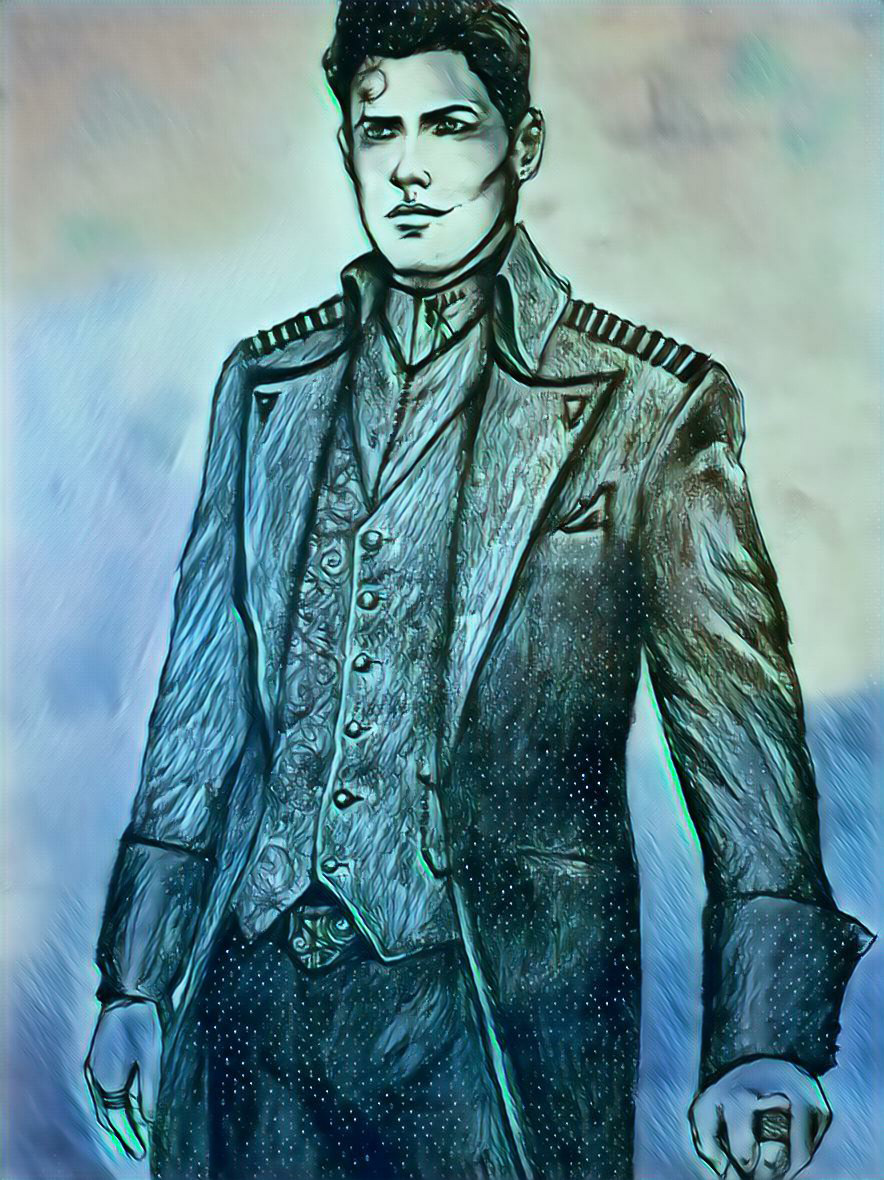
Novyl Saeed's Lucien mon Korell (character from Dunya).
The story revolves around this group of characters living on the fantasy world of Dunya. They are mired in various social and political dramas. While this plays out, there are ancient Titans that are awakening for the first time and no one knows why. That’s another thing our main protagonists’ need to figure out.
I’ve done a lot of world building for this story. There are magic systems, political systems, social-hierarchical systems, and physical sciences. There are some steam-punk elements, as well as a few surprise sci-fi elements.
But what I really want to focus on is the human element. The challenges the characters have to face and how they deal with failure. I think this is the most difficult part of writing stories—figuring out the character development.
How do you create your worlds? Do you picture them in your mind (like character portraits)? Do you create characters first, then the world they live in, or the other way round? Do you think of the plot first, the politics of the world, the architecture, etc? Is it meticulously planned, or is it more an organic process?
That's a good question! I take a lot of inspiration from the world around me and the stories that other people tell.
I’ll be inspired by a song, by a video, by a written passage.
For the Dunya story ... The world came to me first. The wider world I wanted to create. The larger plot I wanted to write about. The Titans from the story came to me first. But that’s not where it actually began.
When I was around 26, I started writing this fantasy story—just as a lark, nothing serious— about this woman travelling alone, with a magical sword she had been given by the Gods. I only wrote a few pages and then it got relegated to the back of my mind. This would go on to be the basis of my fantasy epic, with a LOT of changes, Dunya. I think I only kept the place names from the original story. Haha.
Then in my early 30s I saw this animated video of racing cars on this insane track (Cool Animated Car Race [The Original] (https://www.youtube.com/watch?v=ZLK25tv5C3I&ab_channel=wanmei)
THIS TRACK! OMG! It's INSANE!! But it’s just soooo cool!
When I saw those flying up in the air ....oh man!!! (I’d give anything to race like that!!) That was so INSPIRING! It was watching this that I got the inspiration for “RACA MON”—a galactic space epic! This epic about a very ancient, powerful, alien artifact making its way back to the Milky Way galaxy—and all the characters and races are going to go after it!
This artifact is the size of a planet—and it’s a RACE planet! It has race tracks all over its surface—but this surface is constantly changing—there is an ENORMOUS inner mechanism in this artifact planet that changes the surface in huge blocks. And it’s done while the race is live so participants have to think QUICK! They also have to build their own race machines. The whole point of this artifact was to settle disagreements between galactic species via a race.... A race controlled by the unbiased planetary AI.
This however, happens later. And there is plot, story, and reason behind all this.
And this galactic epic is taking place in the same multiverse as my Dunya (fantasy) story.
So basically how do the awakening Titans tie in with this AI planet returning? Where does this all lead? What is happening?
I’ve been building this multiverse for so long!
At first these were all going to be separate stories—but then I noticed a real interest in cross-overs—like in the Marvel Universe—and I started toying with the ideas of crossing over some of my stories.
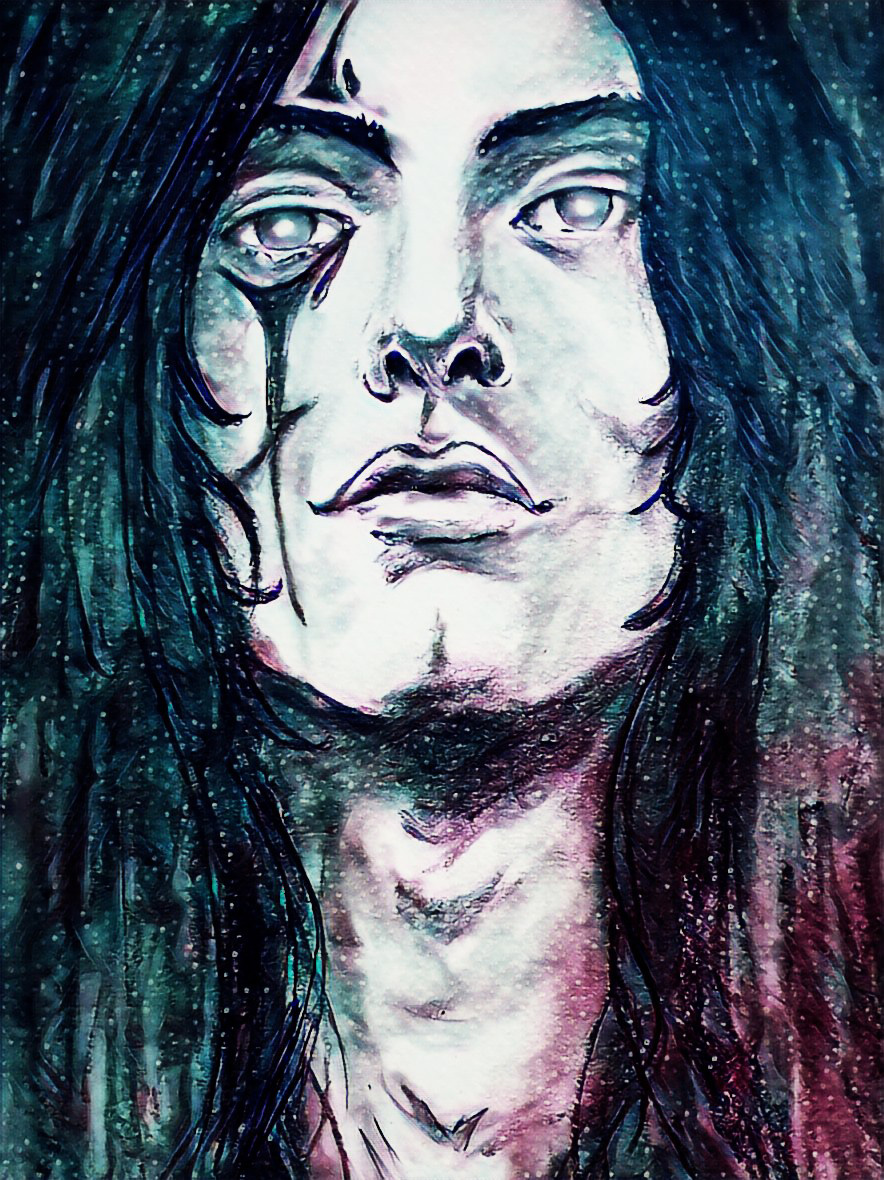
Novyl Saeed's TimeSpaceandDarkness, TheFundamentalPrinciples.
What if these medieval type characters from a fantasy world met these high-tech, alien beings from hyper-advanced civilizations?
I mean then where would the saying “Any sufficiently advanced technology would seem like magic” (AC Clarke) be? What if I pitted REAL magic against this technological magic from a Kardashev III civilization? What then? How would it fit together? Would it make sense?
Would the fantasy magic be magic? Or just more advanced tech misunderstood? Or a bit of both?
Magic and science. Both fascinate me. But both are two sides of the same coin.
And yes! There will be a cross-over between these worlds!!! Woooooooh!!! Oh man! I’m so excited about this whole thing ....
I actually started the penultimate cross-over scene, which is supposed to come at the very end—and that got me so excited—putting all these characters together.
But it’s such an ENORMOUS story, spanning three universes, with multiple character arcs ... It’s a huge undertaking and I sometimes overwhelm myself. As you can imagine.
In the Loud Coffee Press interview, I also talked about James DeVillian—a character I created in my early 20s. His universe is also a part of all this madness.
Some ideas come as plots—some ideas start with a character. It all depends.
You mention in Loud Coffee that imagining a character is like “water cascading through your fingers” and can be made more concrete through drawing, yet it’s still difficult sometimes. Do you find it easier with your own characters or with commissioned art? (Or are they the same?)
I do find things a lot easier with my own characters of course, because I have the freedom to do as I please!
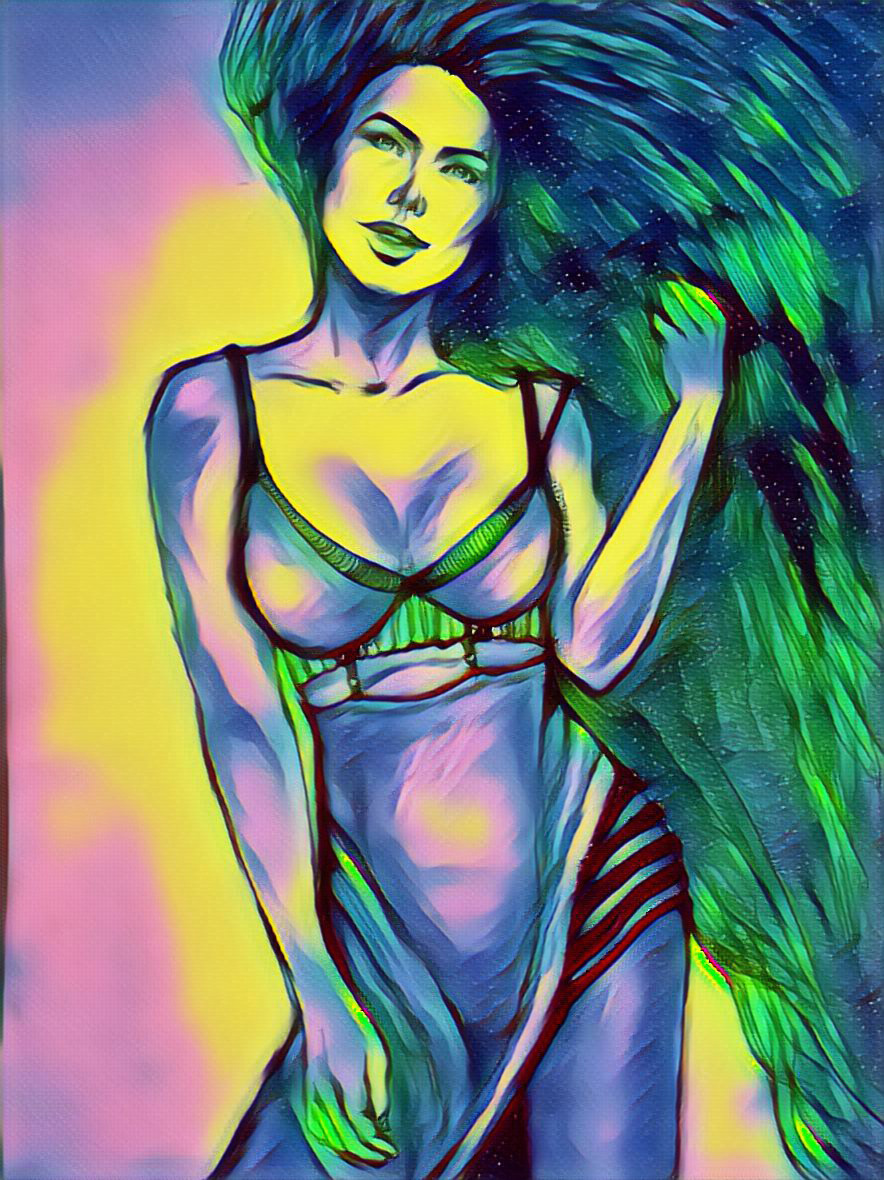
Novyl Saeed's Ate - Goddess (commisioned piece).
The reason I used “water cascading through fingers” is because the image comes, but it’s hard to hang onto—it keeps changing. Developing characters is one of the hardest things I've ever done— especially since its a conscious creation and I’m trying to think of multiple aspects of the personality.
Now that I’ve started taking writing a bit more seriously, I have been on a bit of a learning curve. There is so much that goes into a book— a good book.
Commissioned art isn’t too hard—but it can be difficult because I have to stick to the brief and not get too wild. But I must admit that it has also taught me restraint and patience.
If I’m being honest though—I wouldn’t want to make art comissions a career. I do art because I enjoy it—it’s freeing—and the last thing I want is for it to become a source of stress! XD Which is why I don’t take on that many or even push it.
Where did you live before New Zealand? Lots of places?
I haven't lived in a lot of places—before NZ I was in Pakistan. I was born and raised in Pakistan.
However, we did spend 3 years living in the Middle East—Doha, Qatar. I was very young at the time, but I do remember it.
We also travelled extensively across Europe for a few months. Again, I was very young, but I do remember bits. I remember spending time in the Louvre—Roy Lichtenstein’s artwork left life-long impressions on me. (See the Loud Coffee Press interview where I talk about this!)
Other than that, I pay attention to different cultures, I am passionately curious about them, so I dig deeper and explore and research. The internet is a treasure trove of knowledge. And I’ve followed where knowledge leads! It’s the fun part of life!
I know what it’s like to be from a different culture and upbringing, it really does have an impact on the way you look at things. It has to do with languages ...
Languages—I'm fascinated by them and how they shape perceptions and attitudes. I could write a book about it.
But yeah—Pakistan, Middle East, Europe and now NZ and Australia. Those have been my playgrounds. And everywhere has been different but same. It’s intriguing!
Could you describe more about the culture/values you grew up with/in?
I grew up with very conservative eastern values (aka patriarchal)— which of course, I rebelled against in my teenage years. It was only when I hit my 30s that I developed an appreciation for conservatism.
Eastern values are quite opposite to Western values—speaking from my own experience and time.
Paksitan is a majority Muslim country, so the religion of Islam played a huge role in my upbringing. I had to learn to read the Quran and I wasn't allowed to talk to boys. Women had to dress modestly. The usual stuff.
However, there is one thing about Eastern values that I really like and that is the importance of FAMILY. Pakistan has a family-oriented culture - extended families live together. And it just builds more connection and community, I think. These are the things I will be bringing into my book.
What has your experience been in terms of gender/ethnicity when working on your art or in other work? What different perspectives do you have as compared to “Western” artists/authors? How does this influence your writing (or does it)?
Honestly, ethnicity and gender have played exactly ZERO role in my work. I ignore such things and focus on what I have to do and what I want to do.
I have had people be racist towards me, but I just ignore it and move on. Sometimes, I don’t even notice it.
I have been greatly influenced by a lot of Western artists and authors but I have not forgotten my own values and the culture I grew up in.
In my book, I am trying to bring together the best and worst of both East and West.
In the end, I let my work speak for itself. That is always best.
Your book sounds very interesting ... can you hint at what’s in it, East and West-wise? Do you combine the two, or keep them separate?
Dunya—the major, over-arching plot of the story is about the Titans. These humongous armored statues sit at the four corners of Dunya who are starting to awaken—
North Titan
South Titan
East Titan
West Titan
In the lore, the Titans have been there for as long as the people of Dunya can remember. Most people believe that they hold up the Veil of Mitheras (which is the sky) (Mitheras is a Sun God—who makes his way across the sky of Dunya—like the sun. CF Inspired by Apollo, sun God on his chariot.)
Others believe that the Titans are the protectors of Dunya. Still others believe that the Titans built Dunya. And there are those who think that end of Dunya will be brought about by the Titans.
But no one has any idea why these Titans are awakening now. They were always thought to be inert statues. But not anymore.
And then there are the main players, with their own dramas:
Sateen (main character)—A strong, capable woman, who feels that something is missing from her life & she will be accused of murdering her father
Zenaya—An alcoholic, lesbian warrior
Rakbir—Captain of the Noxx Inferni—a liar and gambler
Vulpes—Ruler of Kal’Nok, with a dark past
Ustav—Second Prince of Smarta, leading a slave rebellion
These are just a few of the main characters, there are others. I won’t go into too many details—suffice to say its an EPIC for a reason!
The empires are Dunya – some of them have Western-type values and some of them have Eastern-type values and one or two are a mixed bag. This story will contain conflicts and misunderstandings that may arise and how these are solved. How the characters interact based on their upbringing – how they perceive the world through the lens of different cultures and philosophical styles. Which is exactly like our own world. That’s what I will be examining to some extent in this story.
And that’s all I'm gonna say for now. I’m still thinking through a lot of plot elements and character development. There is a lot going on in this story! Lots of interesting things!
Finally, what dreams do you have for the future?
My dream is to finish my book! If I do that, then I can work on the other dreams.
I have so many dreams. And I am still chipping away at them. One day at a time.
I dream of a better world. Is that too cheesy?
Novyl Saeed’s work can be found on her website: https://lyv0nlyv0n.wixsite.com/lyv0n. She is also on Instagram and Twitter using the handle @lyv0n. Her Loud Coffee Press interview can be found at https://www.loudcoffeepress.com/post/at-the-corner-of-art-and-writing-an-interview-with-novyl
